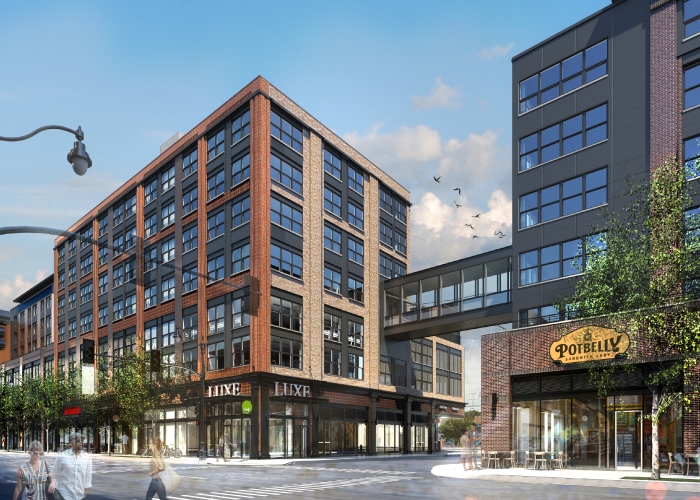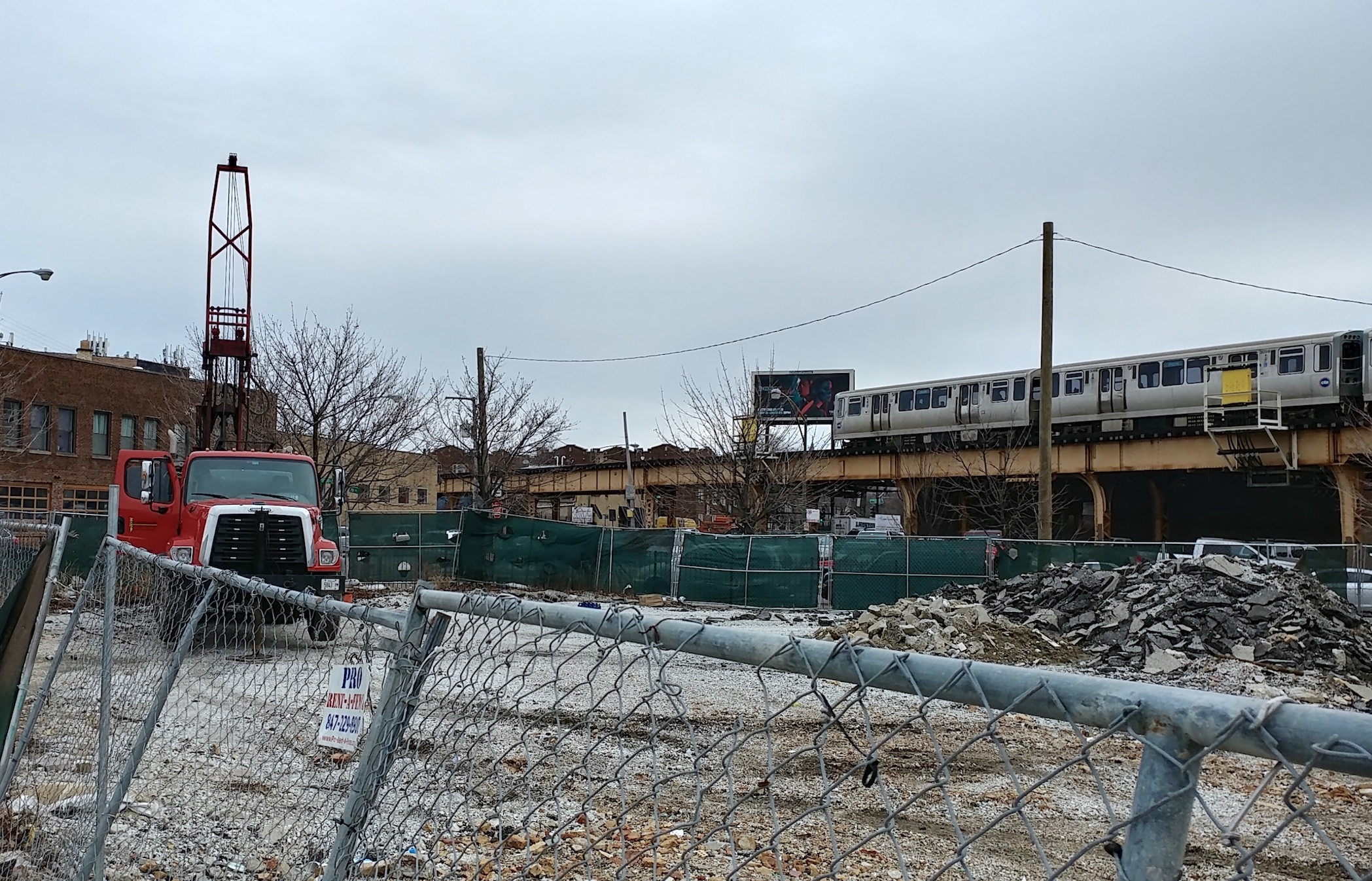After a year of inactivity on the site of the former Mega Mall indoor market in Logan Square, a soil testing crew was out last week at the sprawling Milwaukee Avenue location. A member of the crew with Groundbreaking Exploration, Inc. confirmed that the team was there for soil samping, an activity which generally precedes groundbreaking in the construction process. The project, dubbed Logan’s Crossing, comes from developer Terraco, Inc. and will deliver 240 rental apartments, over 112,000 square feet of commercial space, a whopping 313 vehicle parking spaces, and parking for 125 bicycles.
As one of the largest new developments for the city’s Northwest Side, the upcoming project will no doubt have a major impact on Milwaukee Avenue and Logan Square. And since it’s just one of several major new developments along the Blue Line, it's likely that the hundreds of new residents will continue to push the limits of the already crowded transit line.
Paul Sajovec, chief of staff for 32nd Ward alderman Scott Waguespack, says that the alderman’s staff last spoke with Terraco in December and were told that the development team was still focused on locking down leases for anchor tenants. Last summer, Xsport Fitness dropped out of the project, causing the developer to shuffle floor plans for the development. According to Sajovec, Terraco is also still in talks with a grocery store anchor for the development. It’s still unclear whether Jewel or a different chain will be the anchor grocer for Logan’s Crossing, Sajovec added.
A commercial listing on Loopnet shows that the latest update to the entry was made on January 16 of this year. New renderings and elevations in promotional materials depictw Potbelly, Verizon, and Cupitol Coffee as tenants for the ground-level storefronts along Milwaukee Avenue. A brochure for the project shows that six other retail spaces may still be available. The Loopnet listing also mentions a completion date of 2019 for the new development.
Neither the developer nor listing agent with brokerage Sierra U.S. responded to requests for comment.
Last summer, City Council passed several ordinances related to the development’s impact on the public way. One of the ordinances grants the developer permission to install nine bicycle racks on Milwaukee Avenue. Another allows the developer to install fourteen new planters along Milwaukee, and yet another ordinance shows that Terraco has been cleared to erect and maintain forty-two new lighting fixtures along the busy corridor.
Terraco’s Planned Development, approved by City Council in January 2016, predates changes made to the city’s Affordable Requirements Ordinance—a rule which mandates that developers either set aside a percentage of new residences for affordable rents (defined as being affordable for households making 60 percent of the Area Median Income for the Chicago region) or “buy out” the required on-site ARO units by paying $125,000 per unit into the city’s Affordable Housing Opportunity Fund (AHOF). At the time of its passage, the Logan’s Crossing plan was (and still is) required to make 10 percent of its 240 total residences affordable.

Today, the new ARO rules, which also outline specific pilot zones such as the Milwaukee Avenue Pilot Corridor, would mandate that the developer either deliver 15 percent affordable units on-site or 20 percent for off-site units within the pilot boundaries. The new rules do not allow developers to pay a fee in-lieu of new ARO units.
Daniel LaSpata, a member of Logan Square Neighborhood Association’s Housing and Land Use Committee, says that because of its transit-rich location and the sheer size, the Logan’s Crossing development would have been the perfect opportunity to set a new standard for affordable housing in the booming Logan Square neighborhood. LaSpata suggests that Alderman Waguespack has been soft on developers when it comes to affordable housing and points to other big transit-oriented developments in the 32nd Ward, such as Centrum Bucktown and The Western 1920, where developers opted to pay into the Affordable Housing Opportunity Fund instead of building on-site ARO units.
“We talked to the CHA about project vouchers which would give the developer rents that are much closer to market rate versus ARO units,” LaSpata says, referring to the CHA's Housing Choice Vouchers. “We wanted to see 30 percent affordable units on-site hoping that we could get down to 20 percent, but the alderman said he wasn’t willing to make it happen."
LaSpata added that he and LSNA wish to see the alderman advocate for more family-size units.
However, Sajovec says that Alderman Waguespack was clear on requiring floor plans that would accommodate families. According to Sajovec, the alderman specifically asked to see a “diversity of unit sizes” instead of focusing solely on smaller, more profitable unit types such as studios and one-bedroom apartments.
“In this rush to build higher and higher density, we have developers come back and say that they don’t need certain units,” Sajovec said. “But we suggest that just because the current market is dictating X, Y, or Z, the best thing we can do is to think about the larger planning issues involved and not let it be dictated by today’s market and what is quickest to lease. These 200-year decisions should not be made on what the market is saying this month.”
Sajovec adds that initially some Logan Square groups did not want to see any residential units included in the proposed development, but the alderman did not want to pass up on the opportunity to provide transit-friendly apartments near an important hub. The Logan Square Blue Line station is not only one of only few stations along the O’Hare branch with an elevator, but it also functions as an important bus terminal, he notes.
While the arrival of a soil testing team indicates that there is some movement on the site of the upcoming development, Sajovec warns of assuming too much. “Demolishing the old Mega Mall building didn’t translate into starting construction right away,” he says. Indeed, it has been over a year since the string of buildings were demolished.
However, when the developer does give the alderman’s office notice of a construction start, Sajovec says that the public will be alerted. “When we know, we’ll share what we know.”




